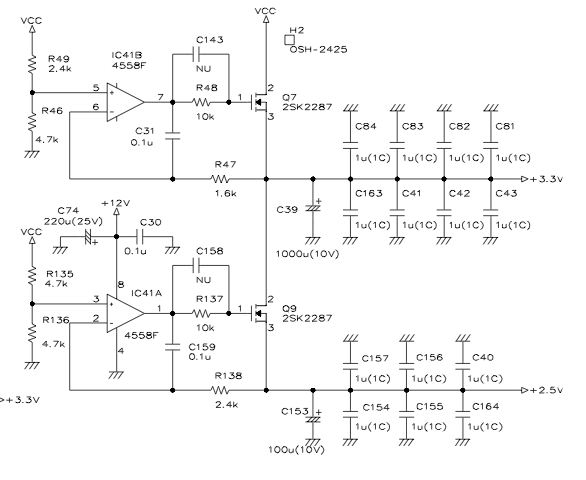OpAmp as a voltage regulator
I was trying to understand the above schematic, which came from the LT342L service manual. It’s the circuit that drives the 2.5 and 3.3v rails on the main (cpu) board. I was confused as to why an opamp was used here, rather than a voltage regulator, and exactly how the circuit was working.
So I posed my question on the Electrical Engineering Stackexchange site and received an answer in minutes.
Covering the 2.5v rail. The circuit starts with R135 and R136, this is a simple voltage divider. It divides the 5v rail in half to give a 2.5v reference. This isn’t used to drive the 2.5v rail directly as the output would be highly load dependent.
The opamp however, does not consume any current and effectively presents no load so our 2.5v will be stable. The opamp is supplied by the 12v rail. It’s implemented in a non-inverting configuration. The output of the opamp drives a MOSFET, which in turn allows current to flow to the 2.5v output. It also connects back into the non-inverting input. This opamp therefore adjusts it’s output to the MOSFET such that 2.5v is allowed to flow through the MOSFET, thereby matching the voltage on the inverting input.
I don’t fully understand the purpose of R138, if anyone knows please leave a comment!
My other question was why do use an opamp at all, rather than a voltage regulator? It seems the reason might be that a regulator designed to work with the required load, at low drop out is unlikely to be available. The fact that you have a 12v rail you can drive the opamp from helps a lot, as it gives you a lot more headroom with which to drive the MOSFET, you don’t need to worry about being too close to the 5v rail voltage. In this case, the MOSFET can source up to 20Amps which is higher than the low drop out regulators generally available are capable of. The design also offers some flexibility, in that if you only need to drive small loads, the MOSFET can be removed and the opamp can drive the rail directly.
Service manual here: LeCroy-5680
